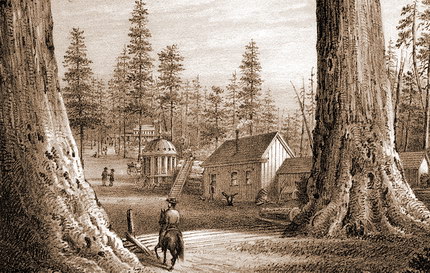
| Galleries — Index |
 |
"The Mammoth Tree Grove" |
 |
Left: Title page engraving by Edward Vischer, "The Mammoth Tree Grove," 1862. The Mammoth Tree Grove is located in Calaveras County, California. In 1852 it became the first big tree grove to be "discovered" by Europeans and ever since has been a major tourist attraction. It was protected in 1931 with the founding of the Calaveras Big Tree State Park. |
 |
 |
Mammoth Grove Hotel, Grounds, |
Two Guardsmen, at the Entrance to the Grove |
 |
 |
Entrance to the Grove, arriving from Murphy's |
Hercules, swept down by December gale 1861 |
 |
 |
 |
The Three Graces |
Mother of the Forest |
Mother and Son |
 |
 |
Hermit (centre) and the Burnt Tree |
The Orphans, at the Entrance of the Grove |
 |
Left: "The Discovery Stump," 2007, While hunting in 1852, Augustus T. Dowd discovered a grove of immense trees which became known as the Mammoth Tree Grove. Several stockholders of the Union Water Company who had employed Dowd as a hunter developed a plan to display a piece of the largest of these trees in New York and other cities. Many people, however, were outraged at the cutting of the tree, Dowd among them. The Discovery tree was felled and sections of its bark and a slab of its cross section were shipped to New York City but the promotion was a commercial failure. Back in California, the remaining stump and log became a tourist attraction as a dance floor, a pavillion, and a bowling alley. Today the stump continues to be an attraction in what is now known as the Calaveras North Grove. While it is a testament to the longevity of the species that the stump and log are still survive after more than 150 years, had the giant tree not been felled, it would still be living. |
| |